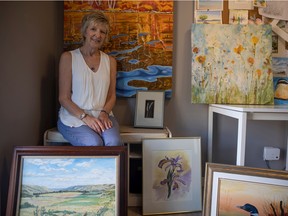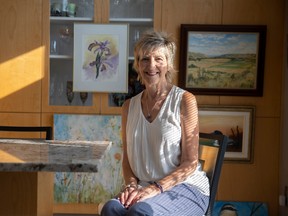Reviews and recommendations are unbiased and products are independently selected. Postmedia may earn an affiliate commission from purchases made through links on this page.
Art
Blank canvas: Charity art sale making COVID comeback – Regina Leader Post
Art from the Attic — a donation-based art sale that raises money for charity — is set to return on Sept. 17 after a two-year COVID hiatus.

Article content
Sherry Wolf believes that artwork should be seen to be appreciated.
Advertisement 2
Article content
In fact, she’s counting on it.
Article content
As one of the volunteer organizers behind Art from the Attic — a long-running charity event in Regina — Wolf is eager to help revive the annual art sale after it was cancelled for two straight years due to the COVID pandemic.
As the name implies, Art from the Attic relies on donations from the public. The pieces are sold for charity during a one-day event that runs Sept. 17 from 10 a.m. to 4 p.m. at the Cathedral Neighbourhood Centre (2900 13th Ave.).
Advertisement 3
Article content
There’s no entry free and the art is “priced to sell.”
The event is operated by the Regina branch of Grandmothers 4 Grandmothers, a national non-profit organization that partners with the Stephen Lewis Foundation. The Toronto-based foundation was created in 2003 to work with grassroots groups in sub-Saharan Africa. Funds are earmarked to support “grandmothers” raising a generation of children who’ve been orphaned due to AIDS and HIV.
According to the Stephen Lewis Foundation, it has raised over $40 million through the grandmothers campaign while contributing to 2,100 projects and 335 community-based organizations in 15 African countries.
The Regina group has been part of that initiative since 2006, but the arrival of COVID presented some unique challenges.
Advertisement 4
Article content
“Like most non-profit organizations, we’ve all been struggling to try and do what’s normal for us, which is fundraise,” Wolf said. “It has been hard. We’ve had some creative ideas (to raise money online) … but it hasn’t quite been the same.”

If not for the pandemic, Art from the Attic would be celebrating its 10th anniversary in 2022. The Regina-based grandmothers are also closing in on $1 million in total charitable contributions since their organization’s inception.
“We’re well over the $900,000 mark,” Wolf noted “We do lots of small fundraisers so it’s a big deal for us to get close to that milestone. We’re hoping with this sale — or by early next year — that we’ll be able to do that. It’s exciting.”
In order to reach their goal, organizers are counting on people to make their artwork available for donation. There are four drop-off locations: Atelier Arts (2075 Albert St.), Benjamin Moore Elements of Colour (4350 Albert St.), Colourburst Paint and Wallpaper (551 Albert St.), and Independent Living (3870 E. Eastgate Drive).
Advertisement 5
Article content
The deadline is Sept. 13.
“We typically get a push at the very end,” Wolf said. “We’re hoping more donations will come in. Our sale depends on the donations. It’s coming in but not as quickly as other years. It takes a while to get back in the swing of things.”
Art from the Attic only accepts two-dimensional pieces (no sculptures or pottery). Donations can be original artwork, prints, photos, water colour, acrylic, oil, metal art, fabric art, etc. — basically “anything that people are willing to donate to us that can hang on a wall.”
Before the artwork goes up for sale, it’s inspected, cleaned and refurbished (when necessary). That process might include replacement of the matting and frame to make it more appealing for potential buyers.
The end result is a piece of art that’s almost like new, even if it was gathering dust in someone’s attic.
“The Regina community is very generous with donations to us; I think people recognize it’s a good cause and it’s a way to recycle their art,” added Wolf, who expects the sale to be well-attended, if history is any indicator.
“People are (usually) lined up at the door on Saturday morning. People know it’s good art and there’s lots of great bargains. It has quite a bit of a following and we’re hoping that’s what happens this year.”

Art
Meet artist J-Positive and the family behind his art store – CBC.ca


- 1 day ago
- News
- Duration 4:42
Joel Jamensky’s sunny disposition explains why the artist with Down syndrome uses the name ‘J-positive’ for his online art business, started with the help of his parents two years ago. “There’s a lot more going on in [Joel’s] art than may be at first glance – just like him,” said his dad, Mark.
Art
Made Right Here: Woodworking art – CTV News Kitchener
[unable to retrieve full-text content]
Made Right Here: Woodworking art CTV News Kitchener





Source link
Art
5 Ways Galleries Are Making the Art World Greener – Artsy
Art Market
Maxwell Rabb
Apr 22, 2024 12:00PM
Exterior view of Oudolf Field at Hauser & Wirth Somerset. Photo by Jason Ingram. Courtesy of Hauser & Wirth.
This year’s Earth Day comes against a stark backdrop. Last year was the warmest on record, and a recent UN climate report recently warned that it’s “now or never to limit global warming.”
As the impacts of climate change grow increasingly urgent, the art community is recognizing its role in addressing environmental challenges through various initiatives and practices. Among the most significant of these is the Gallery Climate Coalition (GCC), founded in 2020, which unites a network of galleries in their commitment to sustainability. The organization—comprising over 900 members—emphasizes how galleries can collectively help to curb environmental damage.
Hauser & Wirth, a prominent member of the GCC, is one of the galleries spearheading these changes, committing to halve its emissions by 2030, which aligns with the 2015 UN Paris Agreement and the GCC’s mission statement.
Portrait of Cliodhna Murphy. Courtesy of Hauser & Wirth.
Portrait of Charles Moffett. Photo by Charlie Rubin. Courtesy of Charles Moffet.
Advertisement
“We are working in an industry that has entrenched habits and behaviors, and we need to steadily identify ways in which to shift the dial,” said Cliodhna Murphy, Hauser & Wirth’s global head of environmental sustainability. “I have been regularly meeting with a group of like-minded individuals from galleries of scale to discuss how we standardize the approach to sustainability across the art world, working towards the same goals. This is something that the GCC is also active in promoting in order to create a level playing field across all of the galleries and how they report their findings.”
In recognition of Earth Day, Artsy spoke with six galleries to identify five key ways that they are making strides toward a greener future.
Introducing greener shipping solutions
Interior view of Hauser & Wirth Downtown Los Angeles, 2019. Photo by Elon Schoenholz. Courtesy of Hauser & Wirth.
The use of air travel to transport artworks is one of the pivotal practices being addressed by galleries to mitigate their environmental impact. The use of sea freight—which, according to the GCC, is 60 times less environmentally damaging than air transportation—is one of the main shifts that is taking place in this regard.
Hauser & Wirth is among the galleries using sea freight for transporting its high-value artworks. “There is a long-held preconception that sea freight is not an option for high-value painting, but I discovered that with the right crating, insurance, and remote supervision, it is absolutely a viable route,” Murphy told Artsy. “As a result, last year, we saved 200 [equivalent tonnes of] carbon dioxide by shifting six exhibitions to sea freight. That’s equivalent [to] 150 return economy flights between London and New York.”
Echoing this commitment, Roberts Projects’s senior registrar and sustainability liaison, Siobhan Bradley, revealed that the most considerable way the Los Angeles–based gallery has improved is through its packing and shipping methods—specifically by introducing alternative packing materials, reusing crates, and consolidating shipments. By doing so, the gallery has cut both environmental and financial costs. “These changes have been well received, particularly because they are generally cost-saving,” Bradley told Artsy.
Taking direct action with benefit exhibitions
Portrait of Quang Bao. Courtesy of 1969 Gallery.
Several galleries are integrating environmental issues into their exhibition programs by hosting benefit exhibitions that directly tackle climate change. One example is Tribeca’s 1969 Gallery, which recently hosted “World Beyond World” from January 18th to February 24th this year. This exhibition brought together 20 artists to support ocean conservation. Proceeds were donated to Only One, a nonprofit based in New York dedicated to restoring ocean health and addressing the climate crisis.
“Eric Oglander has these wonderful sculptural jars filled with an entire ecosystem of algae, snails, and plant life,” said the gallery’s founder, Quang Bao, reflecting on the exhibition. “We had to help keep the jars clean, lit over the days we were closed to help photosynthesis along. I loved them, and I think visitors, especially children, seemed to understand the deeper lesson—that you really have to handle the world we live in with conscience and handheld care.”
Eric Oglander, Jar 4, 2024. Courtesy of 1969 Gallery.
Eric Oglander, Jar 2, 2024. Courtesy of 1969 Gallery.
Charles Moffett is another gallery taking a similar approach. The New York gallery is currently gearing up for its own benefit exhibition next month, working closely with Art to Acres, an initiative focused on funding high-integrity conservation projects worldwide. The show, titled “Not Too Late,” will run from May 3rd to June 7th and will feature all 10 of the gallery’s represented artists, among several others. “[Art to Acres] is converting the actions of what we do in the art world into meaningful change,” founder Charles Moffet told Artsy.
Hauser & Wirth is also hosting an Earth Day 2024 event with Art to Acres, where artist Mika Rottenberg will release a series of lamps. Proceeds will benefit both Art to Acres and the artist’s innovative studio in Tivoli, New York, where she employs plastic reclamation to create her fantastical and playful sculptures with intrusive vines in the Hudson Valley forests.
“One single artist studio or gallery can’t shift the landscape, but collective action amplifies our efforts, builds a movement, and contributes to climate resilience,” said Murphy, referencing that several of the gallery’s artists have embraced sustainable practices, including Anj Smith, Pipilotti Rist, and Larry Bell.
Advocating for sustainable supply chains
Exterior view of Cristea Roberts Gallery. Photo by Jack Hems. Courtesy of Cristea Roberts Gallery.
Actively reducing everyday waste is another way galleries are embedding sustainability practices into their operations. London’s Cristea Roberts Gallery, for example, is taking strides in integrating sustainable materials into its day-to-day operations. Alan Cristea, co-director of the gallery, noted that the gallery is focused on reducing energy consumption and has actively banned polystyrene and reduced single-use plastics in favor of sustainable materials.
“There is still much work to be done, but by opening up conversations and making changes, however small, we hope to build long-term momentum for a sustainable art sector,” said Cristea. “Galleries are also in a unique position to leverage collectors, shipping partners, and the art sector in general to consider working in more permanent, environmentally responsible ways.”
Exterior view of Charles Moffett. Photo by Andy Romer. Courtesy of Charles Moffett.
Often, by switching to sustainable materials and making conscious everyday decisions, galleries and their artists are making a difference. “It’s been really incredible to watch a lot of galleries and artists become more invested in more sustainable practices, whether it’s as simple as changing how we get our power or changing the way in which we ship,” noted Moffett. “These small efforts do tend to have a ripple effect in a business and the art world.”
By implementing these measures, these galleries are both minimizing their environmental impact and influencing the art supply chain to adopt greener practices.
Encouraging online engagement
Portrait of Todd Hosfelt. Courtesy of Hosfelt Gallery.
Portrait of Alan Cristea. Courtesy of Cristea Roberts Gallery.
As digital technologies evolve, so do opportunities for reducing physical travel. Alan Cristea notes that the biggest leap for galleries is circumventing industry norms—which often demand environmentally taxing methods.
Since the COVID-19 pandemic halted the international art world circuit, galleries have become accustomed to exhibiting and selling art online. This also extends to their outreach when it comes to building and maintaining relationships with clients worldwide. In San Francisco, Hosfelt Gallery has drastically reduced unnecessary travel by supplementing in-person meetings with online interactions.
Exterior view of Hosfelt Gallery. Courtesy of Hosfelt Gallery.
“The worst thing any of us do is fly,” founder Todd Hosfelt said. “We need to do less of it. Instead of hopping on a plane for every event, ask, ‘What do you hope to achieve by going?’ and ‘Can you achieve it without flying there?’ In other words, is that trip actually necessary? I used to fly all over the world to do studio visits or meetings….Now, I mostly use Zoom. How many staff people do you really need at an art fair? Can you tack your holiday plans onto the front or back of a work trip? I’m not suggesting never flying anywhere; I’m saying do it thoughtfully.”
Spreading awareness
Exterior view of Roberts Projects. Photo by Eric Staudenmaier. Courtesy of Roberts Projects.
The more people that know about how to make their businesses sustainable, the wider adoption will be. From learning about auditing their environmental impact to getting involved with organizations like Art to Acres and the GCC, gallerists are making each other aware of what they can do. “A big part of it is just education, and awareness, for me, is the first building block in all of this,” said Moffet. “If you don’t understand the impact of your gallery or your museum or your organization, you don’t know what it is that needs to happen in order to reduce your footprint,” he noted.
Programs that address environmental issues—whether in fair-funded talks or action-oriented gallery exhibitions—are crucial ways of fostering a culture of sustainability, which is essential to empowering sustainable action across the art world.
“Galleries—especially members in senior positions—should fully support their staff’s interest in sustainability,” said Robert Projects’s Bradley. “To me, this means creating and allocating time for staff to do research, attend educational seminars or meetings with environmental groups, and then genuinely listening to what they’ve learned and what they feel can be implemented at individual galleries.”
Maxwell Rabb
Maxwell Rabb is Artsy’s Staff Writer.
-
Business14 hours ago
Honda to build electric vehicles and battery plant in Ontario, sources say – Global News
-



 Science14 hours ago
Science14 hours agoWill We Know if TRAPPIST-1e has Life? – Universe Today
-
Investment18 hours ago
Down 80%, Is Carnival Stock a Once-in-a-Generation Investment Opportunity?
-



 Health14 hours ago
Health14 hours agoSimcoe-Muskoka health unit urges residents to get immunized
-



 Health11 hours ago
Health11 hours agoSee how chicken farmers are trying to stop the spread of bird flu – Fox 46 Charlotte
-
News19 hours ago
Honda expected to announce multi-billion dollar deal to assemble EVs in Ontario
-



 Science20 hours ago
Science20 hours agoWatch The World’s First Flying Canoe Take Off
-



 Tech18 hours ago
Tech18 hours agoIndigenous Craft and Vendors Market a success in Halifax




